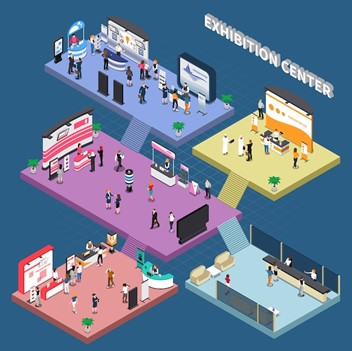The world of conferences and trade shows was hit as hard as an industry could possibly be hit by the Covid pandemic. The industry was completely dependent on physical events, which were almost totally shut down for over a year. During that time, we scrambled to shift everything to completely online events.
Unfortunately, the leading events platforms at the time the pandemic hit weren’t ready for prime time. The top services were primarily designed for in-person events to handle registration and badging. They were quickly modified to add video feeds and were sold as virtual event platforms. Event hosts and attendees found the resulting experience to be confusing, cumbersome, glitchy, unreliable, and low quality.
Several big players in the video space (including Zoom, Cisco, RingCentral, and others), rushed to acquire and/or develop true hybrid event platforms that provide an acceptable, even excellent, experience for remote attendees.
However, the adoption of these new, current generation, hybrid event platforms is suffering. They have some happy customers and are generating some profit for their respective companies, but they aren’t seeing the adoption that I think they warrant. For example, I’m not seeing widespread usage of them in our leading trade shows.
The Hybrid Event Platform Adoption Struggle
There are two big reasons why trade shows aren’t giving enough attention to the hybrid aspect of their shows and these new hybrid event platforms.
The primary reason is that they had such horrible experiences with hybrid during the pandemic. They just want to go back to the good old days of focusing on the in-person event. They don’t know, and don’t care, that the platforms have been improved and the hybrid experience can be excellent.
The second reason is that they don’t fully understand, or appreciate, the benefits of a hybrid event. Their mindset is that the event is physical and anyone who needs to be there should hop on a plane to fully experience the conference. At best, some events may video record some of the sessions and put them on the web for people who couldn’t attend. That is not a hybrid experience!
For hybrid events to achieve their true potential, the events community must do a better job of communicating and understanding the benefits of hybrid events.
Benefits of Hybrid Events
There seems to be this perception that a hybrid event is somehow a lesser version of a trade show or conference. I’ve heard many event planners say that they “had to go hybrid/virtual” because of Covid or other issues. I’m not hearing event planners say they “choose to go hybrid” because they understand that it will be a better overall event for everyone, including the in-person attendees.
Fortunately, I have attended a few fantastic, truly hybrid, events. Notably, they were events hosted by event platform providers. The 2023 Zoomtopia and Webex One events in particular showed the true power of hybrid. To be clear, I attended both events in person, yet I still enjoyed the benefits of the hybrid event experience. The fact that remote attendees were not just passive viewers of a video feed but were able to participate (for example in live QA sessions), made it feel like a bigger, more important, and valuable event for me. My hope is to see a lot more successful hybrid events, but by actual customers of these services.
The benefits for in-person attendees are certainly significant, but they pale in comparison to the benefits for the event hosts! Hybrid events can massively increase their audience, and potential revenue by opening up their show to those who wouldn’t otherwise travel to attend.
I believe event hosts fear that if a show goes hybrid, some attendees might forgo the $500 in-person ticket and choose to just catch the event online for $100. This fear is unfounded. The value of attending in-person is still massive. As wonderful as video can be, it will never match real human contact. Deals get made at these shows over handshakes. Events will not lose significant in-person attendance by going hybrid, but they may grow a significant virtual attendance.
Of course, the greatest beneficiaries of hybrid events are the remote attendees. Accessibility should be a primary concern for event planners! People with disabilities or mobility limitations must be welcomed into our events and accommodated for. This doesn’t just mean having accommodations at the physical location. It means considering those who can’t physically attend, and not just including them but providing them with a great event experience.
Accessibility isn’t just about physical barriers. There are also financial barriers. Obviously, we can’t just make our trade shows free to the world. It is necessary to charge high registration fees for in-person attendees to pay for the in-person event facilities. However, adding an affordable hybrid component can vastly increase the size of your community by including those with smaller budgets.
Finally, accessibility can address geographic barriers. Members of your community may be willing to take a 3-hour flight to your show, but they may not think it merits a 12-hour flight. A hybrid event allows everyone to be included regardless of geographic location and willingness to travel.
Hybrid Events Are More Than Broadcasts
You can’t simply point a webcam at your keynote speaker, put it online, and call your event hybrid. That is a simple broadcast. A hybrid event requires much more.
A crucial element of a true hybrid event is interactivity between remote and in-person attendees. One major way to do this is through internet “chat”.
First, you obviously need some kind of “chat” that is accessible to all attendees. This part is easy as it is provided by all leading event platforms. It is even available on typical webinar platforms.
The second part of the puzzle is a bit trickier. Remote attendees will automatically be placed in the chat when they enter the platform. But we need the in-person attendees to access the chat so that everyone can interact. This can be achieved by best practices during events.
Chat can be displayed on a screen on-stage at the event. This ensures that in-person attendees are aware of remote attendees and encourages in-person attendees to join the chat to participate. Also, Q&A at events can be limited to online chat, pushing in-person attendees to join the chat to ask their questions. I’ve seen both practices put into effect with fantastic results. Once all attendees, remote and physical, are in the same chat, you have a community.
Event platforms will have a separate chat for each session, and an overall event chat, or lobby chat. The leading event platforms do a great job of navigating attendees to the sessions and chats that they want to be in at the right times. But chat, and its proper usage, is just one example of how current generation event platforms foster interactivity. It’s worth doing a deep dive into the feature sets of these platforms to see how they can be used to create an accessible and interactive experience for your attendees.
The Future of Hybrid Events
The potential for hybrid events is ripe with opportunities for innovation and growth. We haven’t even talked about AI or VR yet, both of which have incredible implications for the virtual aspect of hybrid events! But if event hosts simply started using the tools that are available today, we could instantly enjoy a massive positive transformation in the world of conferences and trade shows.
While I hate to be negative, I feel that I must have low expectations here. I would love to say that this is the year of the hybrid event, and that our cutting-edge hybrid event platforms will see a massive surge in usage and adoption.
However, I fear that things will continue along the same lines. Event hosts are still freaked out from the pandemic and afraid to try anything new. The event platform vendors and community aren’t doing enough to educate the public about the value and benefits of hybrid events. There will certainly be more and more successful hybrid events as the years go on, and these events will shine. But I can’t, at this time, forecast that true hybrid events will be ubiquitous, as they should be. Most of our events will continue to be primarily physical, with some sort of virtual afterthought at best for remote attendees.
I hope the world of events proves me wrong and quickly masters hybrid events. It would make the events themselves more successful, profitable, and enjoyable, would grow the communities that these events support, and do the right thing when it comes to accessibility. Until that time, we will all be missing out on better event experiences.
This post is written on behalf of BCStrategies, an industry resource for enterprises, vendors, system integrators, and anyone interested in the growing business communications arena. A supplier of objective information on business communications, BCStrategies is supported by an alliance of leading communication industry advisors, analysts, and consultants who have worked in the various segments of the dynamic business communications market.











